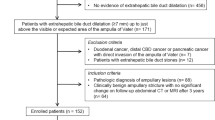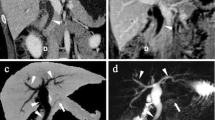Abstract
Purpose
To determine useful CT parameters to differentiate ampullary carcinomas from benign ampullary obstruction.
Materials and methods
This study included 93 patients who underwent abdominal CT, 31 patients with ampullary carcinomas, and 62 patients with benign ampullary obstruction. Two radiologists independently evaluated CT parameters then reached consensus decisions. Statistically significant CT parameters were identified through univariate and multivariate analyses.
Results
In univariate analysis, the presence of ampullary mass, asymmetric, abrupt narrowing of distal common bile duct (CBD), dilated intrahepatic bile duct (IHD), dilated pancreatic duct (PD), peripancreatic lymphadenopathy, duodenal wall thickening, and delayed enhancement were more frequently in ampullary carcinomas observed (P < 0.05). Multivariate logistic regression analysis using significant CT parameters and clinical data from univariate analysis, and clinical symptom with jaundice (P = 0.005) was an independent predictor of ampullary carcinomas. For multivariate analysis using only significant CT parameters, abrupt narrowing of distal CBD was an independent predictor of ampullary carcinomas (P = 0.019). Among various CT criteria, abrupt narrowing of distal CBD and dilated IHD had highest sensitivity (77.4%) and highest accuracy (90.3%).
Conclusion
The abrupt narrowing of distal CBD and dilated IHD is useful for differentiation of ampullary carcinomas from benign entity in patients without the presence of mass.






Similar content being viewed by others
References
Zbar AP, Maor Y, Czerniak A. Imaging tumours of the ampulla of Vater. Surg Oncol. 2012;21:293–8.
Nikolaidis P, Hammond NA, Day K, Yaghmai V, Wood CG III, Mosbach DS, et al. Imaging features of benign and malignant ampullary and periampullary lesions. RadioGraphics. 2014;34:624–41.
Sugita R, Furuta A, Ito K, Fujita N, Chinohasama R, Takahashi S. Periampullary tumors: high-spatial-resolution MR imaging and histopathologic findings in ampullary region specimens. Radiology. 2004;231:767–74.
Andersson M, Kostic S, Johansson M, Lundell L, Asztely M, Hellstrom M. MRI combined with MR cholangiopancreatography versus helical CT in the evaluation of patients with suspected periampullary tumors: a prospective comparative study. Acta Radiol. 2005;46(1):16–27.
Manta R, Conigliaro R, Castellani D, Messerotti A, Bertani H, Sabatino B, et al. Linear endoscopic ultrasonography vs magnetic resonance imaging in ampullary tumors. World J Gastroenterol. 2010;16(44):5592–7.
Chen CH, Yan CC, Yeh YH, Chou DA, Nien CK. Reappraisal of endosonography of ampullary tumors: correlation with transabdominal sonography, CT, and MRI. J Clin Ultrasound. 2009;37(1):18–25.
Lee SH, Jang JS, Lee S, Yeon MH, Kim KB, Park JG, et al. Diagnostic accuracy of the initial endoscopy for ampullary tumors. Clin Endosc. 2015;48:239–46.
Walsh RM, Connelly M, Baker M. Imaging for the diagnosis and staging of periampullary carcinomas. Surg Endosc. 2003;17:1514–20.
Kim MJ, Mitchell DG, Ito K, Outwater EK. Biliary dilatation: differentiation of benign from malignant causes: value of adding conventional MR imaging to MR cholangiopancreatography. Radiology. 2000;214(1):173–81.
Katabathina VS, Dasyam AK, Yasyam N, Hosseinzadeh K. Adult bile duct strictures: role of MR imaging and MR cholangiopancreatography in characterization. RadioGraphics. 2014;34:565–86.
Raman SP, Fishman EK. Abnormalities of the distal common bile duct and ampulla: diagnostic approach and differential diagnosis using multiplanar reformations and 3D imaging. AJR Am J Roentgenol. 2014;203:17–28.
Chen WX, Xie QG, Zhang WF, Zhang X, Hu TT, Xu P, et al. Multiple imaging techniques in the diagnosis of ampullary carcinoma. Hepatobiliary Pancreat Dis Int. 2008;7(6):649–53.
Guo ZJ, Chen YF, Zhang YH, Meng FJ, Lin Q, Cao B, et al. CT virtual endoscopy of the ampulla of Vater: preliminary report. Abdom Imaging. 2011;36:514–9.
Chang S, Lim JH, Choi D, Kim SK, Lee WJ. Differentiation of ampullary tumor from benign papillary stricture by thin section multidetector CT. Abdom Imaging. 2008;33(4):457–62.
Kim TU, Kim S, Lee JW, Woo SK, Lee TH, Choo KS, et al. Ampulla of Vater: comprehensive anatomy, MR imaging of pathologic conditions, and correlation with endoscopy. Eur J Radiol. 2008;66(1):48–64.
Kim SW, Kim SH, Lee DH, Lee SM, Kim YS, Jang JY, et al. Isolated main pancreatic duct dilation: CT differentiation between benign and malignant causes. AJR Am J Roentgenol. 2017;209:1046–55.
Kim S, Lee NK, Lee JW, Kim CW, Lee SH, Kim GH, et al. CT evaluation of the bulging papilla with endoscopic correlation. RadioGraphics. 2007;27(4):1023–38.
Miyakawa S, Ishihara S, Takada T, Miyasaki M, Tsukada K, Nagino M, et al. Flowcharts for the management of biliary tract and ampullary carcinomas. J Hepatobiliary Pancreat Surg. 2008;15:7–14.
Chung YE, Kim MJ, Kim HM, Park MS, Choi JY, Hong SH, et al. Differentiation of benign and malignant ampullary obstructions on MR imaging. Eur J Radiol. 2010;80(2):198–203.
Mirilas P, Colborn GL, Skandalakis LJ, Skandalakis PN, Zoras O, Skandalakis JE. Benign anatomical mistakes: “ampulla of Vater” and “papilla of Vater”. Am Surg. 2005;71:269–74.
Fukukura Y, Fujiyoshi F, Sasaki M, Inoue H, Yonezawa S, Nakajo M. Intraductal papillary mucinous tumors of the pancreas: thin-section helical CT findings. AJR Am J Roentgenol. 2000;174:441–7.
Baron RL. Common bile duct stones: reassessment of criteria for CT diagnosis. Radiology. 1987;162:419–24.
Miller FH, Hwang CM, Gabriel H, Goodhartz LA, Omar AJ, Willis G, et al. Contrast-enhanced helical CT of choledocholithiasis. AJR Am J Roentgenol. 2003;181:125–30.
Park JS, Kim MH, Lee SK, Seo DW, Lee SS, Chang HS, et al. The clinical significance of papillitis of the major duodenal papilla. Gastrointest Endosc. 2002;55:877–82.
Yarze JC. Ischemic-appearing papillitis in a patient with gallstone pancreatitis and cholangitis. Dig Dis Sci. 2003;48:741–2.
Ivanovic AM, Alessandrino F, Maksimovic R, Micev M, Ostojic S, Gore RM, et al. Pathologic subtypes of ampullary adenocarcinoma: value of ampullary MDCT for noninvasive preoperative differentiation. AJR. 2017;208:71–8.
Kim JH, Kim MJ, Chung JJ, Lee WJ, Yoo HS, Lee JT. Differential diagnosis of periampullary carcinomas at MR imaging. RadioGraphics. 2002;22(6):1335–52.
Wu DS, Chen WX, Wang XD, Acharya R, Jiang XH. Pancreaticobiliary duct changes of periampullary carcinomas: quantitative analysis at MR imaging. Eur J of Radiol. 2012;81:2112–7.
Vlachou PA, Khalili K, Jang HJ, Fischer S, Hirschfield GM, Kim TK. IgG4-related sclerosing disease: autoimmune pancreatitis and extrapancreatic manifestations. RadioGraphics. 2011;31(5):1379–402.
Bodily KD, Takahashi N, Fletcher JG, et al. Autoimmune pancreatitis: pancreatic and extrapancreatic imaging findings. AJR Am J Roentgenol. 2009;192(2):431–7.
Irie H, Honda H, Shinozaki K, Yoshimitsu K, Aibe H, Nishie A, et al. MR imaging of ampullary carcinomas. J Comput Assist Tomogr. 2002;26(5):711–7.
Itai Y, Ohtomo K, Kokubo T, Yamauchi T, Minami M, Yashiro N, et al. CT of hepatic masses: significance of prolonged and delayed enhancement. AJR. 1986;146:729–33.
Jang KM, Kim SH, Lee SJ, Park HJ, Choi D, Hwang J. Added value of diffusion weighted. MR imaging in the diagnosis of ampullary carcinoma. Radiology. 2013;266(2):491–501.
Author information
Authors and Affiliations
Corresponding author
Ethics declarations
Conflict of interest
The authors declare that they have no conflict of interest.
Ethical statement
All procedures performed in studies involving human participants were in accordance with the ethical standards of the institutional and/or national research committee and with the 1964 Helsinki declaration and its later amendments or comparable ethical standards. This article does not contain any studies with human participants or animals performed by any of the authors.
Informed consent
Informed consent was obtained from all individual participants included in the study. In addition, a statement affirming approval of the appropriate institutional review boards in accordance with the ethical standards laid down in the 1964 Helsinki declaration and its later amendments or comparable ethical standards.
About this article
Cite this article
Angthong, W., Jiarakoop, K. & Tangtiang, K. Differentiation of benign and malignant ampullary obstruction by multi-row detector CT. Jpn J Radiol 36, 477–488 (2018). https://doi.org/10.1007/s11604-018-0746-z
Received:
Accepted:
Published:
Issue Date:
DOI: https://doi.org/10.1007/s11604-018-0746-z




